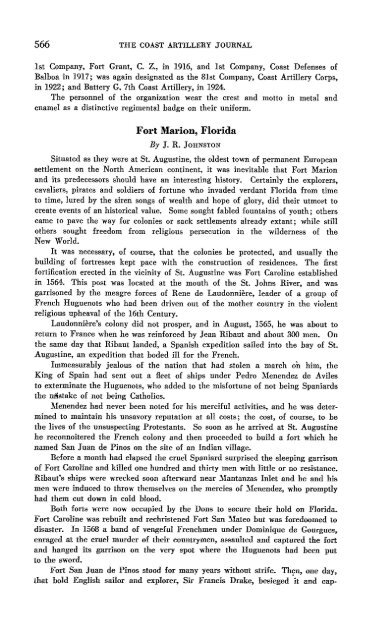COAST ARTILLERY, JOURNAL - Air Defense Artillery
COAST ARTILLERY, JOURNAL - Air Defense Artillery
COAST ARTILLERY, JOURNAL - Air Defense Artillery
Create successful ePaper yourself
Turn your PDF publications into a flip-book with our unique Google optimized e-Paper software.
566 THE <strong>COAST</strong> <strong>ARTILLERY</strong> <strong>JOURNAL</strong><br />
1st Company, Fort Grant, C. Z., in 1916, and 1st Company, Coast <strong>Defense</strong>s of<br />
Balboa in 1917; was again designated as the BIst Company, Coast <strong>Artillery</strong> Corps,<br />
in 1922; and Battery G, 7th Coast <strong>Artillery</strong>, in 1924.<br />
The personnel of the organization wear the crest and motto in metal and<br />
enamel as a distinctive regimental badge on their uniform.<br />
Fort Marion, Florida<br />
By J. R. JOHNSTON<br />
Situated as they were at St. Augustine, the oldest town of permanent European<br />
settlement on the North American continent, it was inevitable that Fort Marion<br />
and its predecessors should have an interesting history. Certainly the explorers,<br />
cavaliers, pirates and soldiers of fortune who invaded verdant Florida from time<br />
to time, lured by the siren songs of wealth and hope of glory, did their utmost to<br />
create events of an historical value. Some sought fabled fountains of youth; others<br />
came to pave the way for colonies or sack settlements already extant; while still<br />
others sought freedom from religious persecution in the wilderness of the<br />
New World.<br />
It was necessary, of course, that the colonies be protected, and usually the<br />
building of fortresses kept pace with the construction of residences. The first<br />
fortification erected in the vicinity of St. Augustine was Fort Caroline established<br />
in 1564. This post was located at the mouth of the St. Johns River, and was<br />
garrisoned by the meagre forces of Rene de Laudonniere, leader of a group of<br />
French Huguenots who had been driven out of the mother country in the violent<br />
religious upheaval of the 16th Century.<br />
Laudonniere's colony did not prosper, and in August, 1565, he was about to<br />
return to France when he was reinforced by Jean Ribaut and about 300 men. On<br />
the same day that Ribaut landed, a Spanish expedition sailed into the bay of St.<br />
Augustine, an expedition that boded ill for the French.<br />
Immeasurably jealous of the nation that had stolen a march on him, the<br />
King of Spain had sent out a fleet of ships under Pedro Menendez de Aviles<br />
to exterminate the Huguenots, who added to the misfortune of not being Spaniards<br />
the mistake of not being Catholics.<br />
Menendez had never been noted for his merciful activities, and he was determined<br />
to maintain his unsavory reputation at all costs; the cost, of course, to be<br />
the lives of the unsuspecting Protestants. So won as he arrived at St. Augustine<br />
he reconnoitered the French colony and then proceeded to build a fort which he<br />
named San Juan de Pinos on the site of an Indian village.<br />
Before a month had elapsed the cruel Spaniard surprised the sleeping garrison<br />
of Fort Caroline and killed one hundred and thirty men with little or no resistance.<br />
Ribaut's ships were wrecked soon afterward near ~lantanzas Inlet and he and his<br />
men were induced to throw themselves on the mercies of ~lenendez, who promptly<br />
had them cut down in cold blood.<br />
Both forts were now occupied by the Dons to secure their hold on Florida.<br />
Fort Caroline was rebuilt and rechristened Fort San ~lateo but was foredoomed to<br />
disaster. In 1568 a band of vengeful Frenchmen under Dominique de Gourgues,<br />
enraged at the cruel murder of their countrymen, assaulted and captured the fort<br />
and hanged its garrison on the very spot where the Huguenots had been put<br />
to the sword.<br />
Fort San Juan de Pinos stood for many years without strife. Th~n, one day,<br />
that bold English sailor and explorer, Sir Francis Drake, besieged it and cap-
















